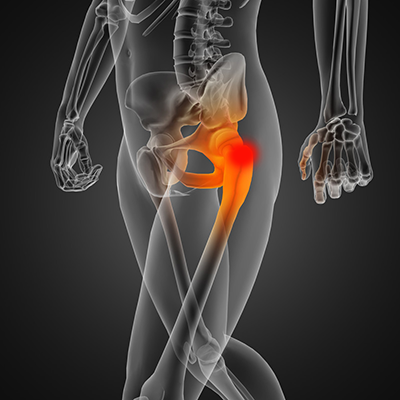Greater trochanteric pain syndrome (GTPS), also known as trochanteric bursitis, greater trochanteric bursitis or hip bursitis, is inflammation of the trochanteric bursa, a sac of fluid protecting the prominent bony part of the hip. The bursa is at the top, outer side of the femur, between the insertion of the gluteus medius and gluteus minimus muscles into the greater trochanter of the femur and the femoral shaft. It has the function, in common with other bursae, of working as a shock absorber and as a spacer for the movement of the muscles adjacent to it (imagine it stops the muscles from wearing out on the bone just like rope would wear out if rubbed on rock).

There are many research studies on shockwave and it’s use in greater trochanteric (GT) bursitis.
Furia et al. (2009) compared outcomes of two groups of patients with chronic greater trochanteric pain syndrome. The study group received low-energy shockwave (SWT) and the control group received other therapies. At 1, 3 and 12 months follow-up all values were significantly improved from the baseline status in both groups. However the patients undergoing SWT improved significantly more than those in the other therapies (control) group (P, 0.001). 76.5% of the patients in the SWT group who participated in regular sporting activities were able to return to their preferred sports. At final follow-up, the number of patients with excellent and good results were significantly higher after shockwave (P, 0.001).
In a quasi-randomized trial, Rompe et al. (2009) compared exercise to corticosteroid injection and shockwave. One month follow up showed corticosteroid success rate, 75%; exercise 7%; shockwave 13%. At 4 months, radial SWT led to significantly better results (68%) exercise (41%) and corticosteroid injection (51%). Fifteen months follow up radial SWT (74%) and exercise (80%) were significantly more successful than was corticosteroid injection (48%). At 4 months from baseline a significantly higher return to sport was reported after shockwave than the other two interventions.
In their excellent review article Del Buono et al. (2012) said repetitive low-energy radial SWT without local anaesthesia did not result in early pain relief, but provided a beneficial effect over months, with a success rate of 68% at 4 months and 74% at 15 months.
Rompe et al. (2009) evaluated the effects of SWT on patients with GT bursitis which had already been treated conservatively but had been unresponsive. The mean results for the shockwave group were statistically improved at 1, 3 and 12 months after treatment compared with the control group. At the 12 months assessment, the shockwave patients had significantly higher excellent and good results compared with the control group patients (79% vs. 36%). No patient reported complications and no patient required additional treatment.
Settings: Anywhere from 1.8 bar or 80-90mj up to 3.0 bar or 120mj. Normally 11-15hz (lower is more painful) for 2000 shocks.
Frequency: Repeated every 7 to 10 days. Sessions as required to eliminate the pain (normally 3-6 but can be a lot more).